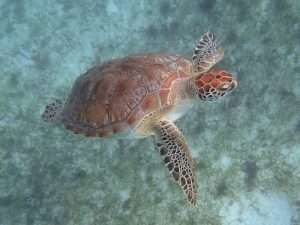 When I was a kid in the 80s, I remember hearing about tortoise shell glasses–also known as horn-rimmed glasses–that were made from the shells of real sea turtles and other chelonians. They were considered trendy when they first appeared in the 1920s, though by the time I came around horn-rimmed glasses were supposedly the mark of uncool nerds. Of course, actual tortoise shells were no longer used as the trade in sea turtle parts was banned in the 1970s by the Convention on International Trade in Endangered Species (CITES), an agreement among almost all the countries in the world.
When I was a kid in the 80s, I remember hearing about tortoise shell glasses–also known as horn-rimmed glasses–that were made from the shells of real sea turtles and other chelonians. They were considered trendy when they first appeared in the 1920s, though by the time I came around horn-rimmed glasses were supposedly the mark of uncool nerds. Of course, actual tortoise shells were no longer used as the trade in sea turtle parts was banned in the 1970s by the Convention on International Trade in Endangered Species (CITES), an agreement among almost all the countries in the world.
There’s been illegal poaching of sea turtles since then for culinary, medicinal and ornamental use, but growing awareness has cut down on demand on the black market. Unfortunately, their terrestrial cousins are facing increased threats from poachers, not just as food or medicine–but as pets.
The Impact of the Exotic Pet Trade
Exotic pets are any non-domesticated animals kept as pets, like birds, reptiles, fish, and wild mammals. Some of these species are easy to breed in captivity, such some freshwater fish kept in aquariums. But many are captured from wild populations; many parrot species, for example, are threatened with extinction simply by how many are trapped for the pet trade.
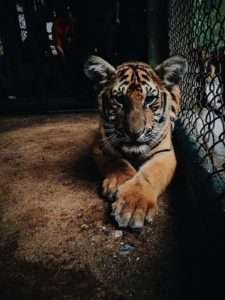 There are a lot of responsible exotic pet owners and breeders out there, to be sure. Unfortunately, the trade is badly marred by a proliferation of poachers, and people whose only thought is to have the coolest, rarest, or most impressive endangered species in their collection. Think of wealthy people with pet lions, tigers, and other big cats, or poachers capturing rare reptile species to sell to the highest bidder. In spite of all the education done by responsible exotic pet enthusiasts, the bad apples make all too big an impact on wildlife populations.
There are a lot of responsible exotic pet owners and breeders out there, to be sure. Unfortunately, the trade is badly marred by a proliferation of poachers, and people whose only thought is to have the coolest, rarest, or most impressive endangered species in their collection. Think of wealthy people with pet lions, tigers, and other big cats, or poachers capturing rare reptile species to sell to the highest bidder. In spite of all the education done by responsible exotic pet enthusiasts, the bad apples make all too big an impact on wildlife populations.
It’s estimated that the global exotic pet trade may be worth over 40 billion dollars; almost half of that may be illegal. Demand for these animals largely comes from North America and Europe, while the countries whose wildlife is most frequently poached are developing nations that have a lot of species biodiversity. Because wildlife may be shipped all over the world rather than under a single jurisdiction, it’s difficult to track or stop black market trade in wildlife, to include endangered species.
Poaching Turtles as Pets
Turtles are no exception. Wildlife officials have seen an increase in poaching of tortoises and freshwater turtles in recent years due to the demand of the exotic pet trade. Because these animals often reproduce slowly, and only after they are several years old, breeding them can require more time and patience than unethical dealers may want to invest. And as turtles are famously slow, it’s all too easy for poachers to pick them up and carry them away.
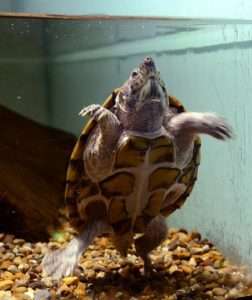 Poaching turtles has some pretty negative consequences. Over half of the world’s 360 species of turtle and tortoise are being pushed toward extinction by the illegal exotic pet trade. It’s not just turtles in tropical areas that are being stolen, though. The United States is seeing thousands of turtles being illegally exported out of the country. From 1999 to 2017, exports of mud turtles (Kinosternon spp.) rose from 1,844 to 40,000, while musk turtles (Sternotherus spp.) saw an export increase from 8,254 to more than 281,000. And other species have seen similar increases both in the United States and beyond.
Poaching turtles has some pretty negative consequences. Over half of the world’s 360 species of turtle and tortoise are being pushed toward extinction by the illegal exotic pet trade. It’s not just turtles in tropical areas that are being stolen, though. The United States is seeing thousands of turtles being illegally exported out of the country. From 1999 to 2017, exports of mud turtles (Kinosternon spp.) rose from 1,844 to 40,000, while musk turtles (Sternotherus spp.) saw an export increase from 8,254 to more than 281,000. And other species have seen similar increases both in the United States and beyond.
When all the turtles of a given species are removed from an area, it has a damaging effect on the ecosystem. Every species has interdependencies with others, and when poaching turtles leads to their extirpation–or even entire extinction–they take with them all the relationships they had with other animals, plants, microbes, and other organisms in their home ecosystems. That leads to less biodiversity, weaker ecosystem health, and potentially the extinction of species that were dependent on the now-missing turtles.
Spreading the Word About Poaching Turtles
The rise of the internet and social media has been a double-edged sword for wildlife. On the one hand, it’s made getting information about the challenges wildlife face much easier to access, and facilitated a lot more necessary conversations about these animals and their habitats. After all, I likely would have a harder time getting the information in this article to you if I were limited to newspapers, magazines, or other physical media that only come out at certain intervals or only in limited regions.
However, there’s a plethora of videos and other media portraying exotic pets as cool and trendy, but neglecting to mention how much work they may need for proper care. Additionally, since most of the internet isn’t professionally edited, anyone can write anything they want. This means that inaccurate information can be quickly and easily passed around, much to the detriment of the animals receiving inadequate or harmful care. And turtles, which can live several decades, may be sentenced to a shortened lifespan consisting of poor health and suffering.
Thankfully enough responsible caretakers of these animals put forth information on proper care, and realistic looks at how much work it takes to give these animals the best life possible in captivity. We cannot duplicate a wild life for them, but we can at least give them the right food, enclosure, and enrichment. So the best thing good exotic pet owners can do is educate, educate, educate. If you have exotic pets, be open about the work you put in giving them good lives. And if someone makes a suggestion that could lead to even better care, be receptive to that new information rather than getting defensive. If you’re trying to help educate someone who may be new to caring for their exotic pets, try to keep things positive and supportive so that they don’t feel attacked (though there’s not much you can do if they decide to double down on their inadequate husbandry instead.)
Making Better Choices
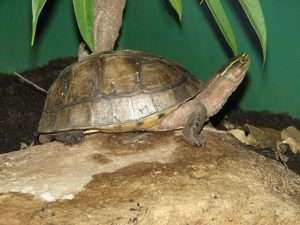 It’s also incredibly easy for people to acquire all sorts of exotic pets. Major chain pet stores may have reptiles, amphibians, birds, and more, and employees may not always have accurate information on how best to care for them. Even independent pet stores vary in quality and understanding of exotic animal care. Many people go to large exotic pet trade shows, where hundreds of vendors proffer thousands of snakes, lizards, insects, spiders, birds, and more to anyone with cash to spend regardless of experience or intent. Craig’s List and similar websites offer opportunities for people to sell exotic wildlife to others in their area with little oversight. And for those who don’t want to have to leave the house, exotic animals can even be bought online and shipped right to your door.
It’s also incredibly easy for people to acquire all sorts of exotic pets. Major chain pet stores may have reptiles, amphibians, birds, and more, and employees may not always have accurate information on how best to care for them. Even independent pet stores vary in quality and understanding of exotic animal care. Many people go to large exotic pet trade shows, where hundreds of vendors proffer thousands of snakes, lizards, insects, spiders, birds, and more to anyone with cash to spend regardless of experience or intent. Craig’s List and similar websites offer opportunities for people to sell exotic wildlife to others in their area with little oversight. And for those who don’t want to have to leave the house, exotic animals can even be bought online and shipped right to your door.
While there are certainly shops and dealers who are mindful of the negative ecological impact of the trade in wild-caught turtles and other wildlife, others aren’t so scrupulous. If you are someone looking to acquire an exotic animal, it’s best to be very particular about sourcing; if a seller can’t tell you much about where an animal came from (for example whether it was captive-bred or wild-caught), find a different source. Avoid endangered or threatened species; even legal trade can encourage illegal black market demand for these species. If it seems too good to be true–a rare animal available for sale, or one selling for an incredibly good price–there’s probably something sketchy in its origin.
Consider giving a home to rescued or otherwise “secondhand” exotic pets, to include turtles. A lot of them end up rehomed or even abandoned because people buy these animals and then either don’t understand how much work they take, or simply get bored with them. And again, turtles’ long lifespans often work against them as few people keep a turtle for its entire decades-long life. Rescues do a lot of good work to help these discarded animals find better homes, and are also often very good sources of information on proper care.
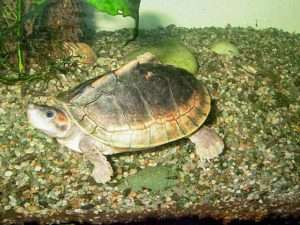 You can also make a difference by simply not purchasing exotic pets in the first place, which reduces the demand for them. The normalization of wildlife as pets creates a setting in which these animals are more readily caught and traded because “Well, it’s okay because those other people are doing it!” There are already tons of domesticated pets–dogs, cats, rabbits, rats, mice, guinea pigs, and more–in need of homes. Sure, they may not be as trendy as sugar gliders, bearded dragons, or rare turtles. But as domesticated animals they have been specifically bred to be around humans and be our companions. They’re much more suitable as pets than the truly wild animals that are passed around in the exotic pet trade–and certainly more than those that were taken directly from the wild and which can no longer contribute their genes to wild populations.
You can also make a difference by simply not purchasing exotic pets in the first place, which reduces the demand for them. The normalization of wildlife as pets creates a setting in which these animals are more readily caught and traded because “Well, it’s okay because those other people are doing it!” There are already tons of domesticated pets–dogs, cats, rabbits, rats, mice, guinea pigs, and more–in need of homes. Sure, they may not be as trendy as sugar gliders, bearded dragons, or rare turtles. But as domesticated animals they have been specifically bred to be around humans and be our companions. They’re much more suitable as pets than the truly wild animals that are passed around in the exotic pet trade–and certainly more than those that were taken directly from the wild and which can no longer contribute their genes to wild populations.
Finally, instead of spending potentially hundreds of dollars on a wild-caught turtle or other animal, try giving that money to a nonprofit organization that works toward wildlife conservation instead. The Orianne Society, for example, focuses on reptile and amphibian conservation. And the Turtle Conservancy, as the name suggests, specifically exists to help promote the protection of endangered chelonians. If you have native turtle species in your area, see if there’s a local organization working on habitat restoration that could use your help with volunteering or a donation.

Thanks-I owned box turtles as a kid- didn’t know better. Had turtles in classroom until they were not allowed because they spread diseases? Do they? And last- sea turtles are my power totem❤️I love swimming with them respectfully and need them as a role model of slowing down and being graceful.
Turtles and other reptiles do have Salmonella as part of their natural microbiome, and unfortunately little kids will sometimes put a smaller turtle in their mouth and then contract Salmonellosis. Hence the ban on selling turtles under four inches in size.
They are truly wonderful creatures, aren’t they though? Not in any hurry, moving through their ecosystems with care.